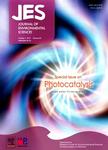Characteristics of change in water quality along reclaimed water intake area of the Chaobai River in Beijing, China
Characteristics of change in water quality along reclaimed water intake area of the Chaobai River in Beijing,China作者机构:Beijing Key Laboratory of Water Resources and Environmental Engineering China University of Geosciences Beijing 100083 China Beijing Xinguohuan Environmental Technology Development Co. Ltd. Beijing 100044 China East China University of Technology Nanchang 330013 China Jiangxi Institute of Geo-Environment Monitoring Nanchang 330012 China
出 版 物:《Journal of Environmental Sciences》 (环境科学学报(英文版))
年 卷 期:2016年第28卷第12期
页 面:93-102页
核心收录:
基 金:supported by the Chinese National Environmental Protection Public Welfare Industry Targeted Research Fund (No. 201309001) the Fundamental Research Funds for the Central Universities (No. 53200859462)
主 题:Reclaimed water Chaobai River Water quality PHREEQC
摘 要:To reveal the basic characteristics and controlling factors of water quality change in the project Wenyu to Chaobai reclaimed water diversion, the water quality in the study area was monitored for one year at seven monitoring sites. Inverse geochemical models of the statistical groups were developed using PHREEQC to elucidate the hydrochemistry characteristics of reclaimed water and the factors. The monitoring results indicated that nitrogen and phosphorus contents were significantly reduced along the river mainly caused by seasonal and location variation. The pH ranged from 7.44 to 9.81. Photosynthesis of algae and denitrification in anaerobic microenvironment ultimately led to a sudden pH increase after the Jian River and the Chaobai River confluence. Mg2+ and SO^- levels dropped obviously in the summer and increased in winter seasons after intersection. Na+ and C1- are relatively stable, and marked drop in the concentration only after the two rivers meet. And there is a decrease of Ca2+ and HCO~ and increase in CO^- during monitoring period. As a whole, the primary ions and nutrient components, including nitrogen and phosphorus, had high levels in winter. Algae's photosynthesis and respiration were observed to have an impact on the river water quality; there was precipitation-dissolution of minerals and denitrification from upstream to downstream. Inverse geochemical PHREEQC modeling confirmed that there was precipitation of aragonite or calcite, and gypsum or anhydrite in summer, and dissolution in winter; as well as precipitation of dolomite in winter, and cationic exchange and denitrification along the river.



